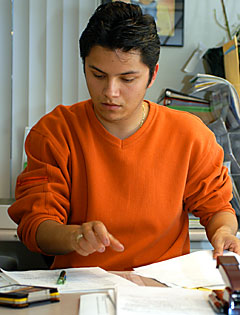 |
|
WILL SEBERGER/Arizona Daily Wildcat
|
Josh Surridge, economics junior and Interfraternity Council president, reviews a UA bursar's statement at his home yesterday. Surridge said, "After looking at these numbers long enough, I'm really starting to realize just how long it will take to pay (my tuition bills)."
|
|
By Keren G. Raz
Arizona Daily Wildcat
Thursday March 6, 2003
Financial aid drives regents' decision to increase tuition
When Oscar Angulo entered UA four years ago, he knew he was going to have to make sacrifices in order to graduate.
With his dad in Mexico and his mom supporting two other sons in Tucson, the applied political economy senior could not rely on his family financially, but still he sacrificed a full-time job to be a full-time student.
The lack of financial support from his family qualified Angulo as one of UA's 5,400 Pell Grant recipients, eligible for a $4,700 grant, the largest grant UA gives to students, according to John Nametz, director of financial aid.
While the $4,700 covers more than just tuition, it barely constitutes one-third of the $13,000 it costs for an in-state student to attend UA.
But students like Angulo may receive larger grants from the university as a result of the largest proposed tuition increase in UA history.
Both President Pete Likins and Student Body President Doug Hartz will go before the Arizona Board of Regents today in Phoenix, asking the regents to raise the cost of tuition for everyone in order to allocate more money for financial aid.
With more financial aid funds, the UA can help students, like Angulo, afford the total cost of higher education, administrators said.
 |
|
CHRYSTAL McCONNELL/Arizona Daily Wildcat
|
Applied political economy senior Oscar Angulo works on homework yesterday. Angulo said he supports an increase in tuition, despite not being able to afford it without increased financial aid.
|
|
Likins will present his proposal asking for a $1,000 tuition increase for in-state undergraduates and a $1,250 increase for out-of-state undergraduates, while Hartz will suggest a $900 increase for resident undergraduates and a $1,450 increase for nonresident undergraduates.
Both proposals allocate 60 percent of tuition revenue to financial aid.
Hartz's proposal gives $770,000 more in aid to resident undergraduates than Likins' proposal.
Administrators, regents, and student leaders are saying that with no state financial aid program, it is time for the universities to take care of their neediest students.
"If we didn't raise tuition, there'd be no way to raise financial aid," said Regent Fred Boice.
As a result, financial aid has become the driving force behind the push for a tuition increase.
Give and take
Amy Bond, an accounting junior, couldn't come to UA without financial aid. She relies on grants and loans to fund her education.
Bond said she supports a large tuition increase, and she wants to see more people like her receive financial aid even though a hike that increases financial aid might require her to take out more loans.
"It's hard for me to come here without financial aid," she said. "I can't imagine denying anyone else the opportunity."
But Bond's opportunity comes at an unaffordable price for students like Josh Surridge, Interfraternity Council president and economics senior.
For four years, Surridge has worked two jobs and borrowed thousands in loans to pay his own way through college, without help from his parents. Next year he will not only pay for his fifth year at UA, but he might also pay the proposed $1,250 increase for out-of-state students.
Surridge opposes a $1,000 tuition hike that will mostly go to financial aid for needy resident undergraduates.
 |
|
We can't take the full burden of this increase and then, on top of that, pay for the needs of others
-Josh Surridge
Interfraternity Council president, economics senior
|
 |
"We can't take the full burden of this increase and then, on top of that, pay for the needs of others," Surridge said.
The need for aid
Right now Angulo has not only taken on one part-time job, but after four years at the UA, he has accumulated over $13,000 in loans.
"Wow. When I say that number, I'm afraid to say it," he said.
By the time Angulo's finished paying off his loans in 10 years, he will have also emptied another $2,000 out of his pockets in interest payments.
Affordability for needy students is not determined by the cost of tuition, according to a study done by the Advisory Committee for Student Financial Assistance for the Department of Education. Affordability is instead determined by the amount of available grants and scholarships that could reduce a student's reliance on work and loans.
In the 2001-2002 school year, loans made up 49.7 percent of the aid distributed to needy in-state undergraduates, according to the Arizona Board of Regents' student financial aid report. The report also said that needy in-state undergraduates took out over $37 million in loans to cover costs that year.
If administrators do set aside 60 percent of the tuition revenue for financial aid, as President Pete Likins has promised, UA should be able to offer needy students up to $6,000 in grants, Nametz said.
Not only will $6,000 protect needy students from a tuition hike, but it will also give them a larger stipend to cover other expenses such as books and housing, Nametz said.
The additional stipend means a lot to those students who, like Angulo, struggle to pay his bills from month to month, Nametz said.
Although few students want to pay $1,000, some say they support a hike that helps other students financially.
Melanie Martinez, an elementary education junior, said she will have to take time out of her studies to work an extra 15 to 20 hours per week in order to help her parents pay an additional $900 to $1,000 for tuition.
"It'll just be more of a headache for me," she said.
But regardless of the headaches, she said she supports a hike that gives aid to other needy students.
Socorro Carrizosa, director of the Chicano-Hispano center, worries about students like Martinez who, when faced with a $1,000 tuition increase, will either take on additional debt, reduce their commitment to academics in order to work, or leave school altogether.
"If tuition goes up, we have a lot of students that are in a notch group, they don't have financial aid, but they also don't have enough money set-aside," she said.
Although regents and administrators understand that some students will struggle to pay an extra $1,000, they said that until the state begins to put more money toward financial aid, there won't be any for those students.
The state contributes 0.2 percent of financial aid, or $1.5 million.
As president-elect of the regents, Regent Chris Herstam will lead the regents in lobbying the Legislature to expand its financial aid program.
"The best hope for assisting those students who don't qualify now for financial aid is for the economy to improve and the state budget problems to go away, and the legislature to invest more money into financial aid," Herstam said. "That's the opportunity for them, and that's the hope, but it's a few years down the road."
For now, as the state legislature struggles with a billion dollar deficit, administrators, regents and student leaders agree that financial aid can only be generated by raising tuition.
Last year a bitter fight between students who wanted a zero percent tuition increase and administrators who wanted a large tuition increase led to a divisive 6-5 vote among the regents. Since then, all sides have come to the consensus that they need to focus on affordability for needy undergraduates, not low tuition.
"Ultimately, we're working right now on trying to provide for those students who, if not provided for, will not go to school," Hartz said. "The goal is to have money so there's no further harm."

